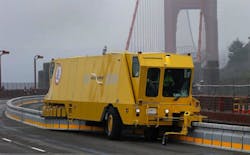Hydraulics Zips Along Golden Gate Bridge
That all changed earlier this year. Officials installed a continuous median of high-density concrete barriers to separate northbound traffic some southbound. That sounds pretty simple, but what makes this solution so innovative is that the barriers are shifted laterally about 11 ft to increase the number of inbound or outbound lanes during morning and afternoon rush hours.
The 11,500-ft median is composed of 3,500 individual barriers linked together through steel hinges at each end and have a molded-in T flange at the top. Each barrier unit weighs 1,500 lb and is tested to withstand impact equivalent to a 4,400-lb truck moving at 62 mph. The key element, though, is a bus-sized vehicle called the Road Zipper. Manufactured by Barrier Systems Inc., Rio Vista, Calif., the Road Zipper straddles the median as it travels from one end of the bridge to the other and repositions the barriers laterally the width of one lane. (Barrier systems also makes Road Zippers that can move barriers laterally two lanes—up to 25.4 ft—in a single pass)
As the Road Zipper travels over the median, a series of rollers move under each barrier, lift it, move it laterally, then gently set it back down. From afar, the motion looks a lot like a zipper in action. From above, the left side of the vehicle drives over the line of barriers, which emerge from the back of the vehicle on the right side. The result is less congested and safer rush-hour traffic.
Hydraulics for work functions is powered by a pressure-compensated piston pump capable of delivering up to 72 lpm of fluid at pressure to 172 bar. Work functions include cylinders for elevation and side-positioning control of the barrier movement sections. The pump also supplies power steering for all four wheels, when needed. The Road Zipper has a 22.8-m turning turning radius with front-wheel steer. When tight maneuvering is needed, though, it can be shifted to 4-wheel steer, which cuts the turning radius to only 11.4 m.
During normal operation, gravity can cause the barriers to migrate backward or forward from inclines and declines in the road surface. For example, barriers will tend to migrate down a hill or resist angular repositioning around a curve. This movement results from gravity and rolling resistance within the machine as the barrier passes through the series of rollers. Spring forces in the hinge assemblies between each barrier can also contribute for positioning error.
A capstan drive works to counteract these tendencies. The capstan drive consists of a hydraulic motor, two pumps, two rubber capstan wheels mounted under the machine, and controls. Without the capstan drive, barriers would tend to be spaced too far apart or too close together at the beginning and end of hills, valleys, and curves. The result would be excessive tensile or compressive stress on the hinges. The capstan compensates for irregularities to maintain the wall in a neutral, stable position.
The Road Zipper and Road Zipper System (which includes the interlocked median barriers) are manufactured by Barrier Systems Corp., a division of Lindsay Transportation Solutions, Omaha, Neb. For more information, visit www.barriersystemsinc.com.





